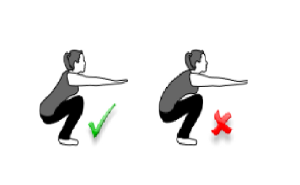 Squatting exercises have long been touted as the magic behind everything from total body fitness to weight loss. Basically, squatting exercises involve bending at the waist and bending your knees, with or without additional weight. Trainers everywhere inject squats and squat combinations into exercise routines for their clients often. But are squatting exercises doing more harm that good? Continue reading “Are Squats Hurting Your Back?”
Squatting exercises have long been touted as the magic behind everything from total body fitness to weight loss. Basically, squatting exercises involve bending at the waist and bending your knees, with or without additional weight. Trainers everywhere inject squats and squat combinations into exercise routines for their clients often. But are squatting exercises doing more harm that good? Continue reading “Are Squats Hurting Your Back?”
Tag: gym
Muscle Dysmorphia aka Bigorexia Becoming Epidemic?
Bigorexia is the common term for muscle dysmorphia (MDM), a disorder characterized by a fear of being too small, and perceiving oneself as being too weak, even though a person may actually be large and muscular. Surprisingly, this disorder occurs primarily in males with a well-defined, muscular build. It may affect, to some degree, 1 in 10 gym goers.
Dissatisfaction with your body can be a risk factor for the onset of eating disorders, for the abuse of anabolic androgenic steroids (AAS) and can cause issues with self-image that can lead to related psychiatric symptoms. It’s pretty serious.
To be clear, there is absolutely nothing wrong with the fitness goal of gaining muscle (hypertrophy). It improves performance, vitality, strength, power, functionality, and self esteem. It’s just that sometimes, if conditions are right in the minds of men and women, things get a little out of control.
Continue reading “Muscle Dysmorphia aka Bigorexia Becoming Epidemic?”
Triathlete, Coach, Motivator Talks Massage
 When most of us are just slapping the SNOOZE button for the second time, Bo Rivera is already in high gear at the gym. Not just any gym, Santa Clara’s premiere gym, Fitness Never Sleeps (FNS). And he’s not there just for his own wellness, he’s part of the FNS team, both as superstar coach and marketing lead. He’s been with FNS since the club opened in 2012 helping hundreds of athletes and weekend warriors build new skills, acquire new fitness habits, and push themselves to reach their personal goals.
When most of us are just slapping the SNOOZE button for the second time, Bo Rivera is already in high gear at the gym. Not just any gym, Santa Clara’s premiere gym, Fitness Never Sleeps (FNS). And he’s not there just for his own wellness, he’s part of the FNS team, both as superstar coach and marketing lead. He’s been with FNS since the club opened in 2012 helping hundreds of athletes and weekend warriors build new skills, acquire new fitness habits, and push themselves to reach their personal goals.
Bo has a true passion for fitness and helping others achieve their fitness goals. He’s a lifelong athlete who grew up playing soccer in high school and college, and has been an avid snowboarder, cyclist, and martial artist for more than 10 years. He’s committed to building excellent habits for fitness, nutrition, wellness, and a positive attitude.
Bo practices what he preaches, too. He’s an accomplished triathlete and designed his own customized fitness and nutrition program. He’s also a big believer in the benefits of massage therapy in helping him maintain maximum wellness.
Bo’s passion is contagious, as any FNS member will tell you. We were curious as to why he believes massage is such an important part of a wellness program, and a little more about his own motivations, so we sat down with Bo for a quick Q&A.
Continue reading “Triathlete, Coach, Motivator Talks Massage”
Massage for Weight Lifters
Millions of people use weight training as a way to improve coordination, increase muscle mass, speed metabolism, and improve strength. When proper form is used, weight training can be very effective in helping you look and feel better.
By definition, weight training increases the amount of effort your muscles exert and challenges your metabolism to keep up with the increased energy needed to sustain those efforts. During the process, muscles react different ways. Sometimes weight lifters experience soreness because of microtears in the muscle fibers, or feel sore from the buildup of lactic acid and other natural body chemicals in the stressed areas. Even when your form is perfect, all this exertion and stressing of muscles can cause aches and pains. That’s where massage can really help.
Continue reading “Massage for Weight Lifters”
Top 10 Wellness New Year’s Resolutions
About one in three Americans make a New Year’s resolution. It’s a great tradition, offering us an opportunity to kick bad habits, create new opportunities, soften the rough edges of our behavior, and polish up relationships. The trick, of course, is sticking with it.
Just in case you were sitting around wondering which one of the zillions of promises you’d like to make to yourself, we’ve collected 10 resolutions that are relatively easy to keep and will certainly go a long way toward a healthier and happier 2015.
1. More FTF and less TXT. It’s easy to think that a random text now and then can substitute for a real conversation if you’re working on keeping relationships with friends and relatives strong. It doesn’t. Try talking to your friends and relatives more IN PERSON, or at least hear their voices. Use tech like FaceTime and Skype more. Put DOWN the phone while you eat or talk with others. You will find the quality of your relationships improve, your fingers aren’t as sore from texting, and you’ll avoid that $300 texting-while-driving traffic ticket, too. Continue reading “Top 10 Wellness New Year’s Resolutions”
Six Ways to Improve Your Posture
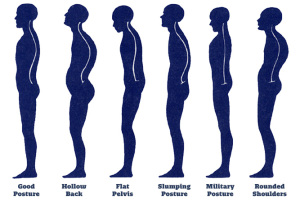 Over time, gravity and bad habits can take their toll on your body and try to declare victory over the structural muscles that keep our bones and muscles aligned. The result is poor posture.
Over time, gravity and bad habits can take their toll on your body and try to declare victory over the structural muscles that keep our bones and muscles aligned. The result is poor posture.
Classic signs of poor posture include rounded shoulders, a jutted chin, a pot belly, bent knees when standing or walking, back pain, muscle fatigue, and headaches. While we can’t fight gravity, we can take control of posture and do things the help keep muscles strong and your body trained for better posture.
1 Know what good posture looks like. Check yourself out in a mirror. Good posture while standing is a straight back, squared shoulders, chin up, chest out, stomach in, feet forward, your hips and knees in a neutral position. If you can draw a straight line from your earlobe through your shoulder, hip, knee, to the middle of your ankle, you’re good!
2 Sit up straight. Your mom was right. Use a chair that offers lower back support and sit all the way back against the back of the chair. Keep both feet on the ground or footrest. Adjust the height so your arms are flexed at 75-90 degrees at the elbow. Use this technique when driving, too! Continue reading “Six Ways to Improve Your Posture”
Take Care of Your Quadriceps (Quads)
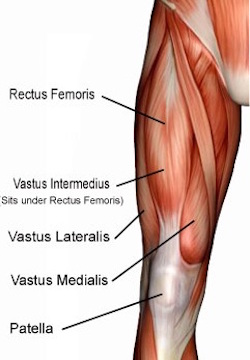
Your “Quads” (quadriceps) are actually a muscle group. They’re not just one muscle, but four muscles, each contributing to the extension of your knee joint and the flexing of your hip. The quad muscles are crucial in running, squatting and jumping.
The quads are anatomically located in the anterior (front) compartment of the thigh. The quad muscle group is made of up of three large muscles: vastus lateralis, vastus medialis, vastus intermedius, and the smaller rectus femorus. Vastus lateralis is on the outside of the thigh, medialis on the inside, rectus femoris is on top, and intermedius is in the center hidden below the rectus femoris.
The quadricep muscles originate at the ilium (upper part of your hip bone) and femur (thighbone) and come together in a tendon around your patella (kneecap) and then attach to your tibia (shinbone).
Read this if you work out more than 4 times a week
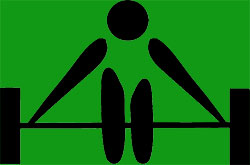 There’s a special tribe of gym goers who are full-on focused on a specific goal–maybe it’s weight loss, getting six pack abs, or some rehab from an injury–and they’re driving toward the goal by going to the gym, a lot. This tribe can be found in a gym just about EVERY day, in fact. They’re the hard-core gym members, and they are serious about their bodies.
There’s a special tribe of gym goers who are full-on focused on a specific goal–maybe it’s weight loss, getting six pack abs, or some rehab from an injury–and they’re driving toward the goal by going to the gym, a lot. This tribe can be found in a gym just about EVERY day, in fact. They’re the hard-core gym members, and they are serious about their bodies.
While most people who go to the gym a lot will tell you about the rush they get from a great workout or that they can’t imagine NOT going to the gym, they’re probably NOT talking about soreness and pain they often feel from the stress of the workout, the run, or the CrossFit-Zumba–spinning marathon. The fact is, you’re getting bigger, more toned or faster because as you work those muscles, they are constantly stretching and tearing, and then regenerating building new tissue or stronger tissue. Micro-tears in muscles over a long term with no rest can result in pain and soreness, and, if left alone, can actually lead to a weakening of muscle tissue that may cause injury.
Continue reading “Read this if you work out more than 4 times a week”
10 Ways to Improve Your Quality of Life
Sometimes it’s the little things that make the biggest difference. See how many of these YOU can do!
1. Learn something new. Teach yourself some new recipes. Learn to play poker. Try your hand at Portuguese. Why not? Stimulate your brain and you will be happier.
2. Talk to someone. Not texting. Not email. Not a note on the table. Brew up some tea or hang out at Starbucks and really TALK to someone about anything–not just serious stuff.
3. Eat better. OK. You know this one. Better nutrition leads to feeling better and that leads to a higher quality of life.
4. Think positively. Catch yourself when you start to look on the dull side of life or when you become a “negative nelly.” Be positive. It works.
You’re a Climber. You’re Sore. Now What?
If you worked hard to reach your goals during your climb, you’re probably sore. Climbing is one of the most efficient workouts you can get! You use virtually every muscle in your body in a mashup of coordination, strength training, and balance. It’s good for the mind, too, developing self-confidence, learning to visualize and problem-solve. And of course it’s fun!
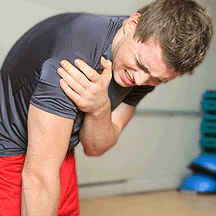
With all that vigorous exercise, it’s no wonder your body complains sometimes! Though not all soreness indicates an injury. Some soreness results from muscle fatigue, some from other stresses. But some soreness is a red flag–so if the pain persists, see a healthcare professional–otherwise, there are some easy and practical things you can do to reduce or eliminate the pain you’re feeling. Continue reading “You’re a Climber. You’re Sore. Now What?”

